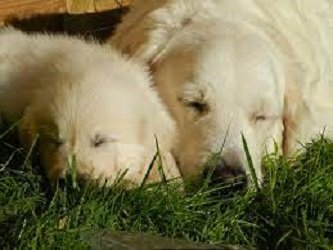Dog breeding is a very lucrative industry that is growing rapidly each year. It is because there is a high demand for unique breeds and people are willing to spend some extra bucks to get them. People are also curious about the science of breeding. One of the most recurring question that people ask is that do puppies take after their mom and dad?
Yes, Puppies do take after their mom and dad. However, many dog breeders believe that the mom has more influence on a puppy than a father. However, this does not imply that a puppy will have a 50/50 chance of resembling its parents in look or attributes. It may resemble either of his parents or cut a completely different figure. Let us dig in to find more about this topic.

Dominant And Recessive Genes
When the genes of the pup’s parents are united, just a subset of them influences his physical and behavioral characteristics. This is because some genes are dominant, and others are recessive. According to the Australian Shepherd Health & Genetics Institute, dominant genes always outnumber recessive ones and determine which qualities your pup will exhibit as part of his physical appearance, also known as his phenotype.
Unless they are mixed, recessive genes are usually hidden. These genes remain part of your dog’s ultimate genetic composition, known as his genotype, and are passable to his children. As a result, there are three conceivable gene combinations: two dominant, two recessive, or one dominant and one recessive.
Mating
When two dogs with dominant genes, denoted as “BB,” mate, their progeny will have those genes and look like them. The same is true if two pups have all recessive genes, denoted by “bb,” but things get tricky when pups with a combination of recessive and dominant genes, denoted by “Bb,” marry.
Their puppies have a 75% likelihood of looking like their parents. According to the Gwinnett County Public Schools website, the pups have a 25% chance of resembling neither parent if their hidden recessive genes combine into the “bb” configuration. Of course, if one parent has dominant “BB” genes, the offspring will inherit those characteristics, but if one parent has recessive “bb” genes, the offspring will have a 50-50 chance of resembling either mom or dad.
What Characteristics Does a Puppy Get from Its Parents?
The temperament of a puppy is influenced by genetics. The temperament of a dog relates to its inherent disposition, and research has shown that several dog breeds share temperamental hereditary features.
How It Works
A dog breeder can make a puppy with the temperamental characteristics that they choose. All they have to do is breed two dogs of the same breed, and the pups will inherit the temperaments of their parents. If the offspring mature and are bred with their breed type, their progeny will inherit the temperamental features of the original breed.
This can continue for future generations. The breeder will crossbreed several breeds if they want to eliminate some unwanted temperamental qualities in a specific breed. This is seen in the numerous designer dogs available today, such as cockapoos and Labradoodles. Crossbreeding is beneficial since it can assist to balance out extreme personality traits and produce more balanced pups.
Temperament Features
Breeding dogs demonstrates that temperamental qualities can be handed down from a parent to a puppy. Individual breeds share temperament features, which can help you choose the perfect dog breed for your home.
However, this does not imply that dogs are preprogrammed genetic machines. However, this does not imply that dogs are preprogrammed genetic machines. It is impossible for two dogs, even if they are of the same breed or litter, to have the same personality.
In most circumstances, a dog’s environment will also play a key influence in determining its temperamental features. As a result, if you want to bring a new puppy into your home, you should learn about its breed and personal history.
Is Dog Behaviour Mouldable?
According to the prevailing belief, young pups come to us as blank slates. Full of promise and boundless potential, ready to be shaped into your ideal companion as long as you do your part – provide plenty of love, the necessary amount of discipline, and suitable training along the way. There is no reason why your puppy should not grow up to be a model canine citizen if you are a caring, responsible pet owner.
Isn’t it true that “bad” dogs are the result of terrible owners? After all, it all boils down to how you raise kids. Is it possible to change someone’s behavior? To a point, of course, it is. You can only tweak what you already have, not make a new puppy from scratch. So, if you have certain goals for your puppy or require a dog with a specific personality type, make sure you buy a dog with a temperament you can live with!
Please keep in mind that none of this should be interpreted as a defense of breed-specific stereotyping or discrimination based on the assumption that certain breeds are inherently aggressive or otherwise “bad.” There is a tremendous amount of genetic variability within every breed – so much so that making reliable predictions about behavior based solely on breed identification is impossible.
Some Tips That Can Be Helpful
Training is essential: It may appear that teaching your dog to sit, come, or lie down has little to do with barking, jumping, or chewing problems, but it does.
Positive behavior training tells your dog that when he does what you want, it builds your bond, and it gives mental activity that will tire him out, making him less inclined to disobey. Try adding a new instruction every week and see how it goes.
Exercise
Exercise helps in the release of energy: A tired dog is a nice dog. If you’re gone for 12 hours a day and your dog’s walk consists of a fast sprint into the backyard, your pet isn’t getting enough exercise. Excess energy may be directed to chewing your shoes or tugging you on the leash. Puppies have more energy than older dogs and need more exercise. In addition, the breed of your dog has an impact.
Prevent your dog from picking up harmful habits: Make your home puppy-proof. Place shoes and toys in their proper places. Pick up any houseplants that have fallen to the ground. Even if you have a fenced-in yard, keep an eye on the puppy. It is easier to prevent undesirable habits from being formed than it is to correct them 0nce they have been formed.
Rewarding System – Does it Work?
Encourage appropriate behavior by rewarding them: Praise and pet your dog if he is sleeping peacefully instead of jumping or barking. Tell your dog what a fantastic dog he is as he walks beside you on the leash. It is easier for him to comprehend what you want him to do if you use words like “sit” rather than “don’t jump” or “heel” rather than “don’t pull.”
The difference is made by consistency: If you do not feed the dog at the table but your husband or children do, he will learn to beg. Or, if you ignore him when he jumps on you but others pet him when he does, you can guess what he’ll do. When it comes to establishing dog behavior standards, everyone must follow the same norms.
Tactical Tips for Unwanted Dog Behaviours
1. Jumping |
| · The first step is to meet your dog calmly so that he does not become overly enthusiastic. |
| · Because the goal of jumping up is to get attention, refusing to provide your attention is the most effective technique to deter jumping. Turn your back or stand like a statue. |
| · If you’ve taught your dog the “sit” command, request a sit – a sitting dog cannot jump. Then get down on your dog’s level and provide him with the attention he craves. The dog should eventually initiate it without being prompted. |
2. Chewing |
| · Chewing is a natural and important habit in dogs, especially when they are teething. The most efficient strategy to keep your belongings from being destroyed is to keep them out of your dog’s reach. |
| · Give your dog chewable materials that are appropriate for his age and size, but never old socks or shoes. |
| · Give him plenty of physical and mental stimulation. |
| · Teach him the phrase “leave it.” |
3. Try not to pull your dog |
| · If you tug on the leash, your dog will instinctively pull back. |
| · When your dog walks by your side, praise, click or offer goodies to encourage him to walk politely on the leash. |
| · He must learn to pay attention to you regardless of how fascinating the setting is, therefore, it’s best to start practicing in a place with few distractions. |
4. Barking |
| · Dogs bark, but barking can rapidly become a nuisance. Teach the command “quiet” or “enough.” Then, when your dog begins to bark, you gently reply, “quiet.” He should stop barking and come to you, where you can praise or reward him. |
| · Remember that the more excited you become, the more likely your dog will believe there is something to bark about. |
| · It’s a good idea to think about why he’s barking – whether he’s bored, needs exercise, or is fearful of other dogs and people and needs more socialization. |
| · If he’s barking for attention, don’t give it to him unless he’s silent. |
Be Patient
Dogs are creatures of habit and changing them can take a lot of effort. Your dog wants to comprehend what you want him to do, but it will take time and patience to communicate your goals and guide your pup away from undesirable behaviors and toward better ones.
Try To Boost Your Pets Confidence
You need to understand that you can only play the card you’ve been dealt; every dog has their personality and behavioral inclinations, for better or worse. We can do a lot with training and careful management to help these dogs live safer, happier lives.
These strategies will boost their confidence, teach them better coping skills for dealing with stress, and improve their attachment with their owners. However, this cannot change who they are. That is usually Normal. We would advise you to focus on what you can change and accept what you can’t.
To Sum It Up
Puppies do take after their mom and Dad. Some of their attributes do pass on, but some recessive genes that are present in the parents can become active – and exhibit a different set of characteristics. Thus, the offspring are not exact copies of their parents but the amalgamation of some traits and a few additions due to the recessive genes.

